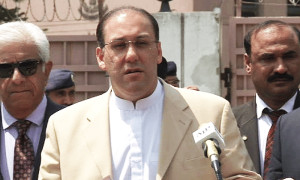صحرائی
Chief Minister (5k+ posts)
ISLAMABAD: In its latest World Economic Outlook report, the International Monetary Fund has included Pakistan in emerging market economies.
An emerging market economy is the one that is progressing toward a more advanced stage, usually by means of rapid growth and industrialisation. These countries experience an expanding role both in the world economy and on the political frontier.
The IMF projects that Pakistan’s real GDP will continue to grow modestly, reaching 5.2 per cent by 2020.
It was 4.0 per cent in 2014, 4.2 per cent in 2015 and is projected to reach 4.5 per cent in 2016.
Real Gross Domestic Product (real GDP) is a macroeconomic measure of the value of economic output adjusted for price changes - inflation or deflation.
The IMF statistics, included in its 2015 World Economic outlook report, also show that consumer prices in Pakistan increased by 8.6 per cent in 2014 but reduced to 4.5 per cent to 2015.
The prices will rise slightly to 4.7 per cent in 2016 and are projected to reach 5.0 per cent in 2020.
A consumer price index measures changes in the price level of a market basket of consumer goods and services purchased by households.
The annual percentage change in a CPI is used as a measure of inflation.
Pakistan’s current account balance was minus 1.3 per cent in 2014, improved to minus 0.8 in 2015 and is projected to further improve to minus 0.5 in 2016.
The current account balance shows the difference between a nation’s savings and its investment and is an important indicator of an economy’s health.
A negative current account balance indicates that the country is a net borrower.
Pakistan’s unemployment rate in 2014 was 6.7 per cent, which drops slightly to 6.5 per cent in 2015 and is projected to drop further to 6.0 per cent in 2016.
The unemployment rate is calculated as a percentage by dividing the number of unemployed individuals by all individuals currently in the labor force.
SOURCE: GULF TODAY
An emerging market economy is the one that is progressing toward a more advanced stage, usually by means of rapid growth and industrialisation. These countries experience an expanding role both in the world economy and on the political frontier.
The IMF projects that Pakistan’s real GDP will continue to grow modestly, reaching 5.2 per cent by 2020.
It was 4.0 per cent in 2014, 4.2 per cent in 2015 and is projected to reach 4.5 per cent in 2016.
Real Gross Domestic Product (real GDP) is a macroeconomic measure of the value of economic output adjusted for price changes - inflation or deflation.
The IMF statistics, included in its 2015 World Economic outlook report, also show that consumer prices in Pakistan increased by 8.6 per cent in 2014 but reduced to 4.5 per cent to 2015.
The prices will rise slightly to 4.7 per cent in 2016 and are projected to reach 5.0 per cent in 2020.
A consumer price index measures changes in the price level of a market basket of consumer goods and services purchased by households.
The annual percentage change in a CPI is used as a measure of inflation.
Pakistan’s current account balance was minus 1.3 per cent in 2014, improved to minus 0.8 in 2015 and is projected to further improve to minus 0.5 in 2016.
The current account balance shows the difference between a nation’s savings and its investment and is an important indicator of an economy’s health.
A negative current account balance indicates that the country is a net borrower.
Pakistan’s unemployment rate in 2014 was 6.7 per cent, which drops slightly to 6.5 per cent in 2015 and is projected to drop further to 6.0 per cent in 2016.
The unemployment rate is calculated as a percentage by dividing the number of unemployed individuals by all individuals currently in the labor force.
SOURCE: GULF TODAY
- Featured Thumbs
- https://pbs.twimg.com/media/CTUETX9WoAARmNR.jpg:large


































